We might picture dramatic waterfalls deep in rainforests or far-flung remote mountain jungles, but many of these mesmerising water features can be found much closer to home. They’re often otherworldly places to swim or watch for wildlife – with kingfishers and herons making the occasional appearance if you’re lucky.
From South Wales to Northern Ireland, and plenty of places in between, we’ve explored some of the most spectacular waterfalls in the UK.
Our guide explores some of Britain most impressive waterfalls, from the tallest and the most powerful waterfalls in the UK to some of the most enchanting – discover Aira Force, Steall Falls, Pistyll Rhaeadr and more.
Looking for more fabulous British landscapes? Check out our guides to mountains, rivers and forests.
The best waterfalls in England
Aira Force, Cumbria
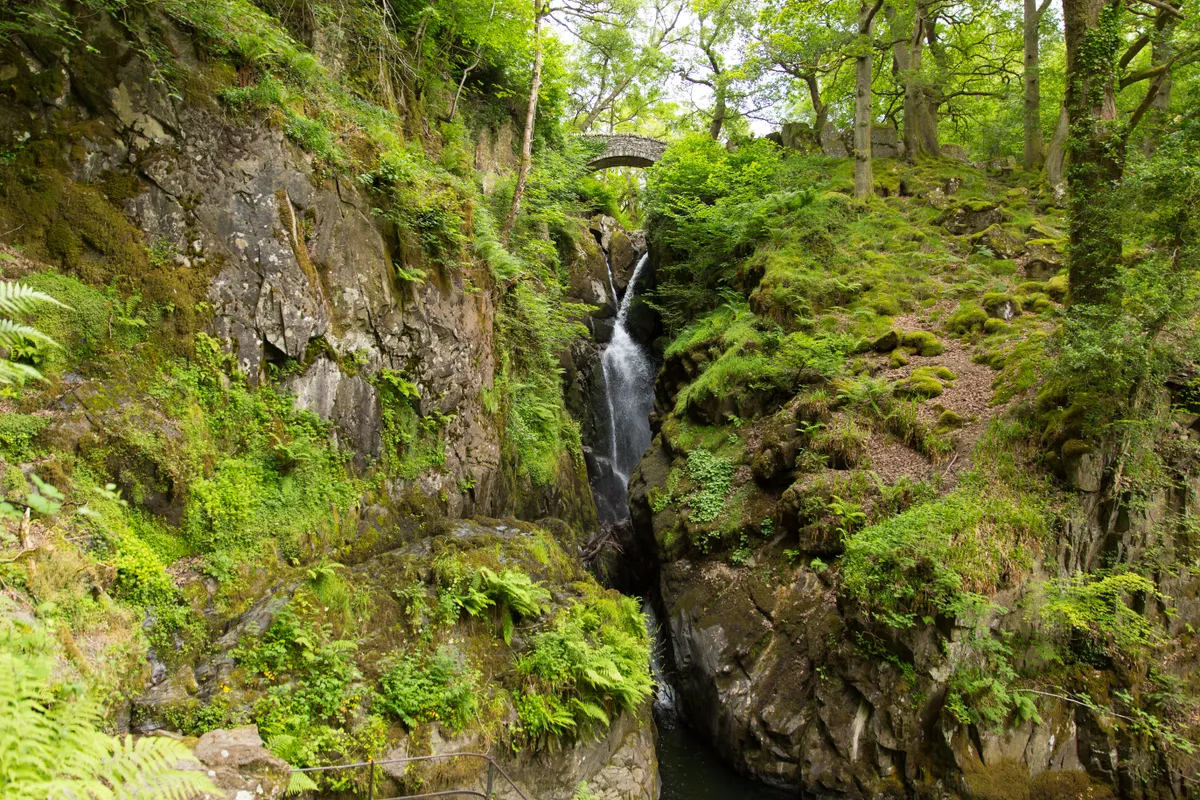
Probably the most popular waterfall in the Lake District, Aira Force is part of a circular National Trust trail. You can walk over a bridge that arches over the top of the falls for a stunning photo opportunity.
Kinder Waterfall, Derbyshire
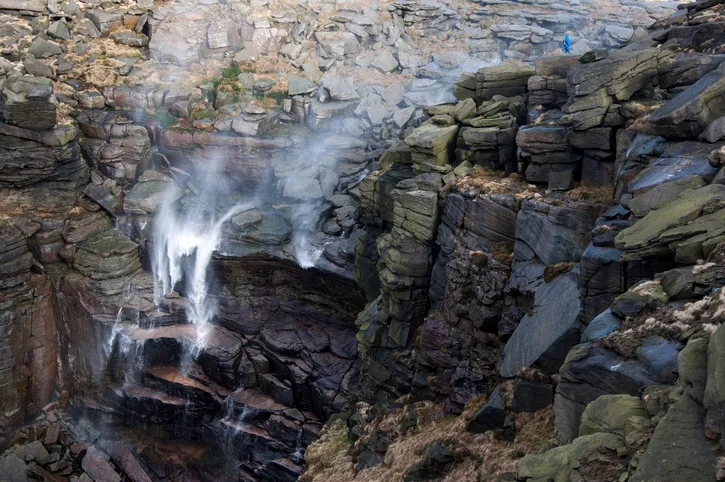
Sandwiched between Manchester and Sheffield in the Peak District National Park, the bleak but beautiful upland plateau of Kinder Scout is a landscape of wind-swept crags, perfect for hikers and scramblers alike.
The rugged waterfall of Kinder Downfall is one of Kinder's highlights. When strong westerlies blow, the waters are forced upwards back onto the plateau.
Littlebredy, Dorset
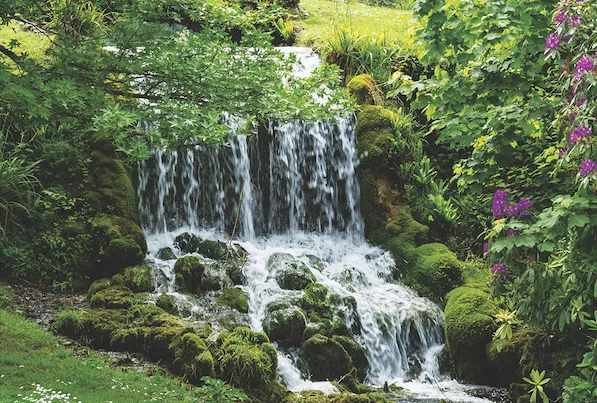
The River Bride rises from beneath an artificial lake at Bridehead House beside the small village of Littlebredy. Tumbling over a man-made waterfall, it continues its journey for 6.5 miles to Burton Bradstock on the Dorset coast. Don’t miss the walled gardens, herbaceous borders, mansion and village church.
High Force, County Durham
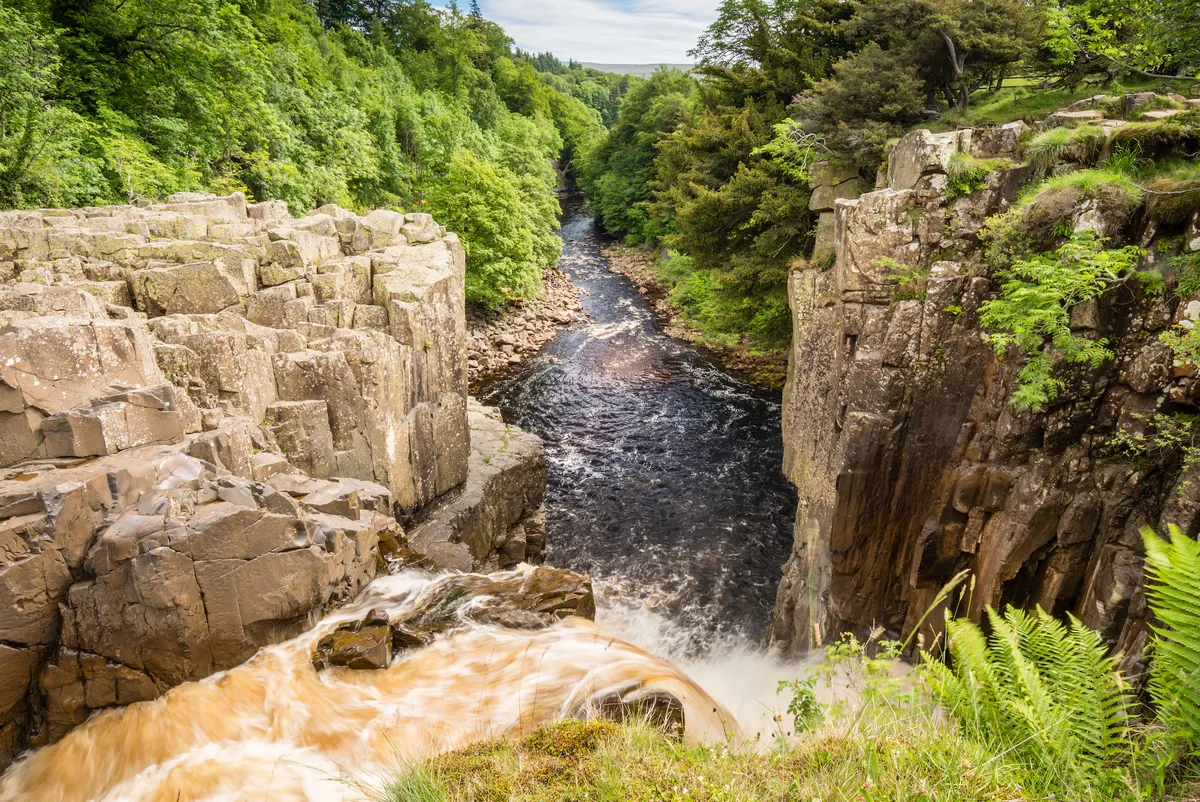
High Force is an easily accessible and enchanting waterfall not far from Raby Castle. Known as England’s largest waterfall, the scene makes for pleasant viewing, especially with the nearby picnic area and seasonal gift shop.
You’ll hear the roar of High Force long before you see the falls. The first sighting, from a juniper thicket on the lip of the gorge, is rendered even more impressive by its abruptness.
People often mistakenly name High Force, which is 21.5m (70ft) tall, the highest waterfall in England. But it’s Cautley Spout in the Yorkshire Dales, which boasts a single 76m (249ft) drop, that truly deserves the title. High Force is, however, England’s largest waterfall by volume – something that you can’t fail to notice as you watch the thunderous deluge from your vantage point.
The upper whinstone layers of High Force contrast sharply with the lower, sandstone, shale and limestone. The water erodes these softer rocks more quickly, to the extent that periodically, they can no longer support the harder dolerite, which collapses into the river. The waterfall has so far retreated 700m (2,297ft) into its gorge.
Canonteign Falls, Devon
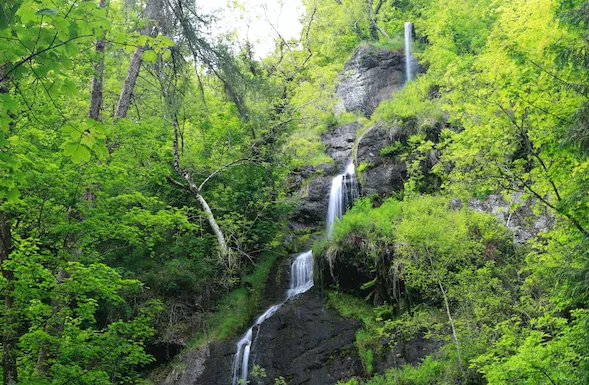
Canonteign Falls in the leafy Teign Valley, four miles east of Becky Falls, is home to England’s highest man-made waterfall – Lady Exmouth Falls – which stands at a mighty 70m high and offers some of Devon’s prettiest panoramic views of the surrounding countryside.
In 1890, under the direction of Lady Exmouth, miners rerouted a stream over the edge of a cliff to create the lofty falls, which now cascade through a leafy woodland. The original natural waterfall, Clampitt Falls, can be found further down the valley.
Virginia Water, Surrey
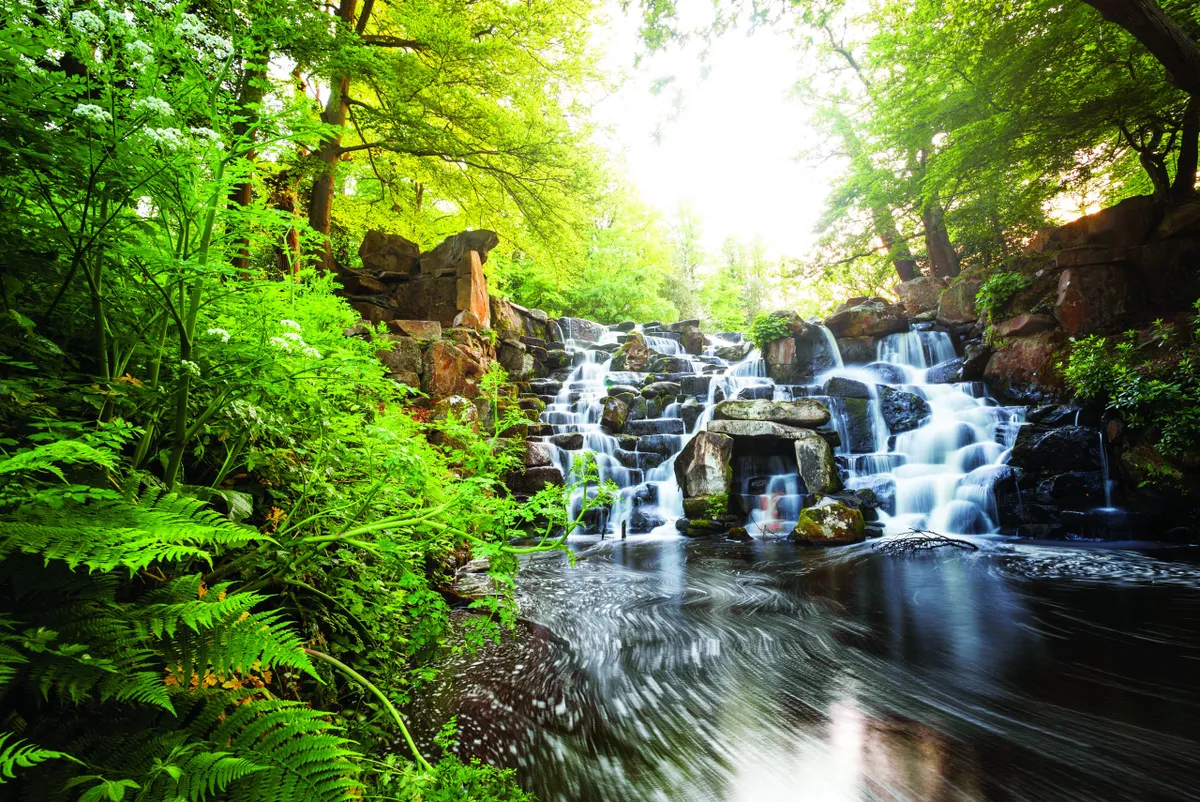
At the southern end of Virginia Water in Windsor Great Park is The Cascade, an ornamental waterfall constructed of stone. Admire the tiered falls – as well as Roman ruins, a totem pole and waterside woodlands – on a five-mile circuit of the lake.
Castle Carr, West Yorkshire
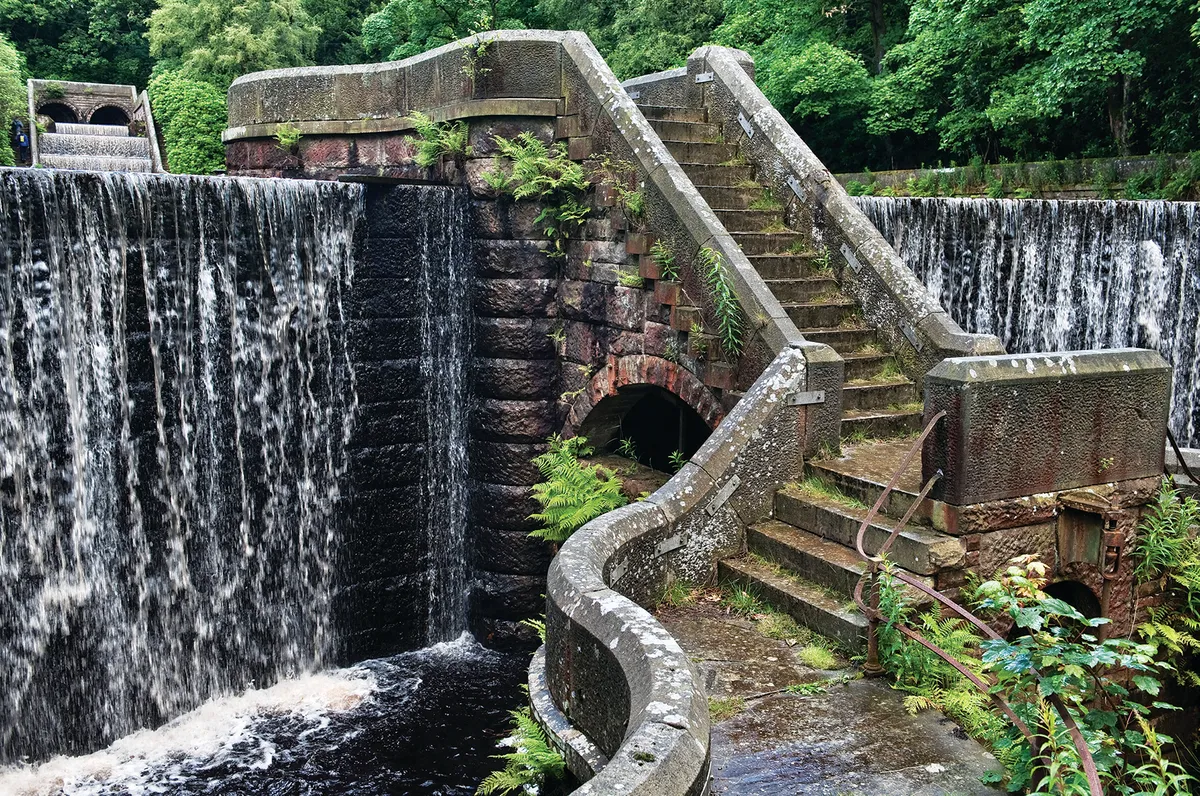
Open to the public for just a single day each year, the Castle Carr water garden in Luddenden Dean is a true secret garden. The castle itself is now derelict but evidence of this ambitious property can be seen throughout the grounds, not least at the southern end of the reservoirs where a broad, arched waterfall crashes down beside an elaborate staircase.
Gaping Gill, Yorkshire
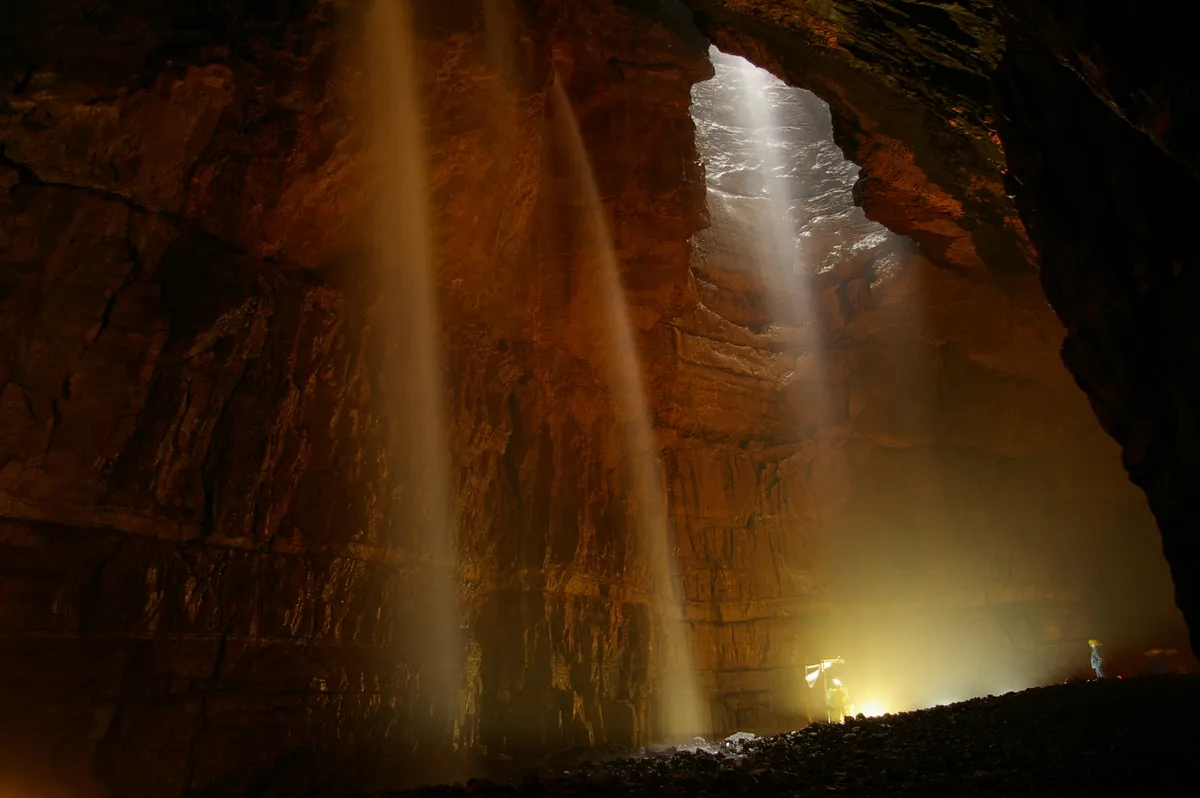
Gaping Gill is spectacular not just because it’s the highest unbroken waterfall in England, but also because it plunges into a deep pothole. Twice a year, the Bradford and Craven Pothole Club allow tourists to venture down into the cavern.
Kyoto Garden, Holland Park, London
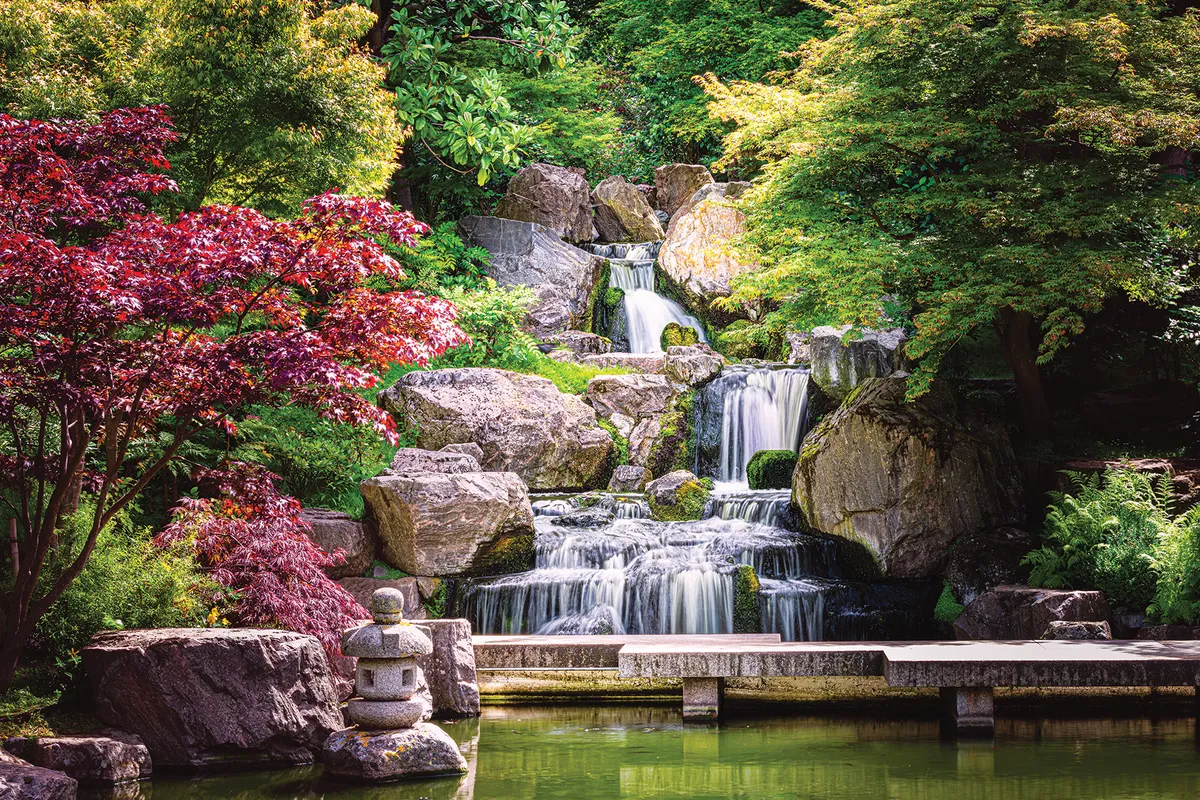
This Japanese garden, opened in 1991, was a gift from the city of Kyoto in Japan. With its strutting peacocks, lethargic koi carp, ruby-coloured acers and rocky waterfall, it is a place of real serenity in the heart of the capital.
Stanley Ghyll Force, Cumbria
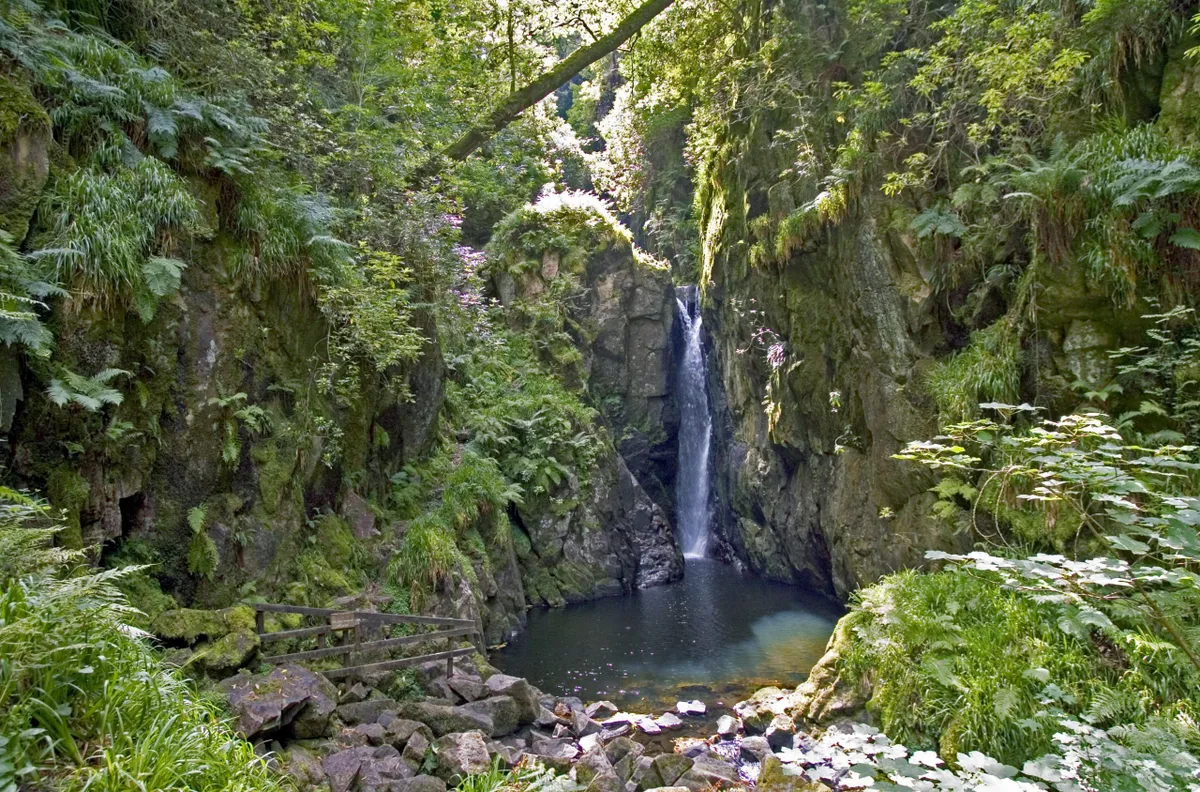
Plunging 20m into the surprising seclusion of a deep gorge in Eskdale, Stanley Ghyll Force feels miles from the tourist trappings and rambling hikers found in much of the Lake District.
The landscape and flora of the woodland makes this place feel typically English yet somehow tropical at the same time, adding to the enchantment of the gorge, of which the waterfall is the main attraction.
Lydford Gorge, Devon
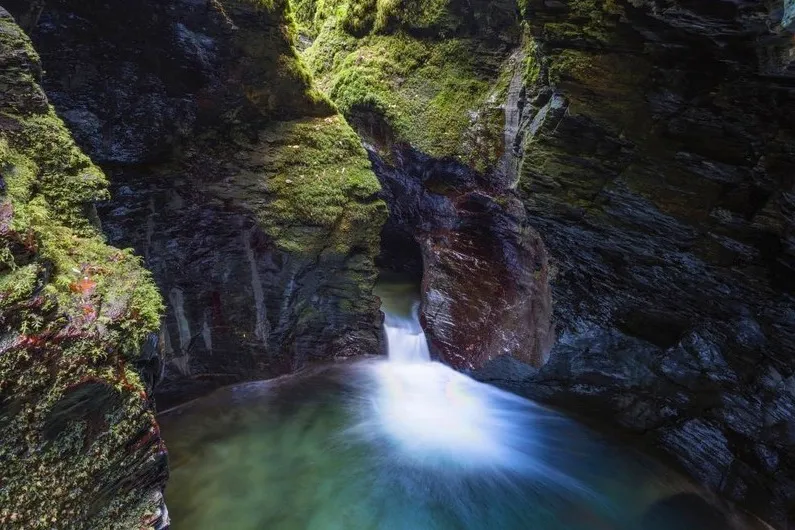
Lydford Gorge is a sylvan delight of laurel, cherry, elm and lime trees. You might catch the blue flash of a kingfisher or a heron lifting elegantly from the water as you encounter the impressive White Lady Waterfall.
This is the deepest gorge in south-west England and includes beautiful ancient oak woodland; the trees’ fresh green leaves newly unfurled. A series of spectacular potholes line the gorge, the largest of which is Devil’s Cauldron. After heavy rain, dramatic whirlpools form in the craterous riverbed.
Catrigg Force, Yorkshire
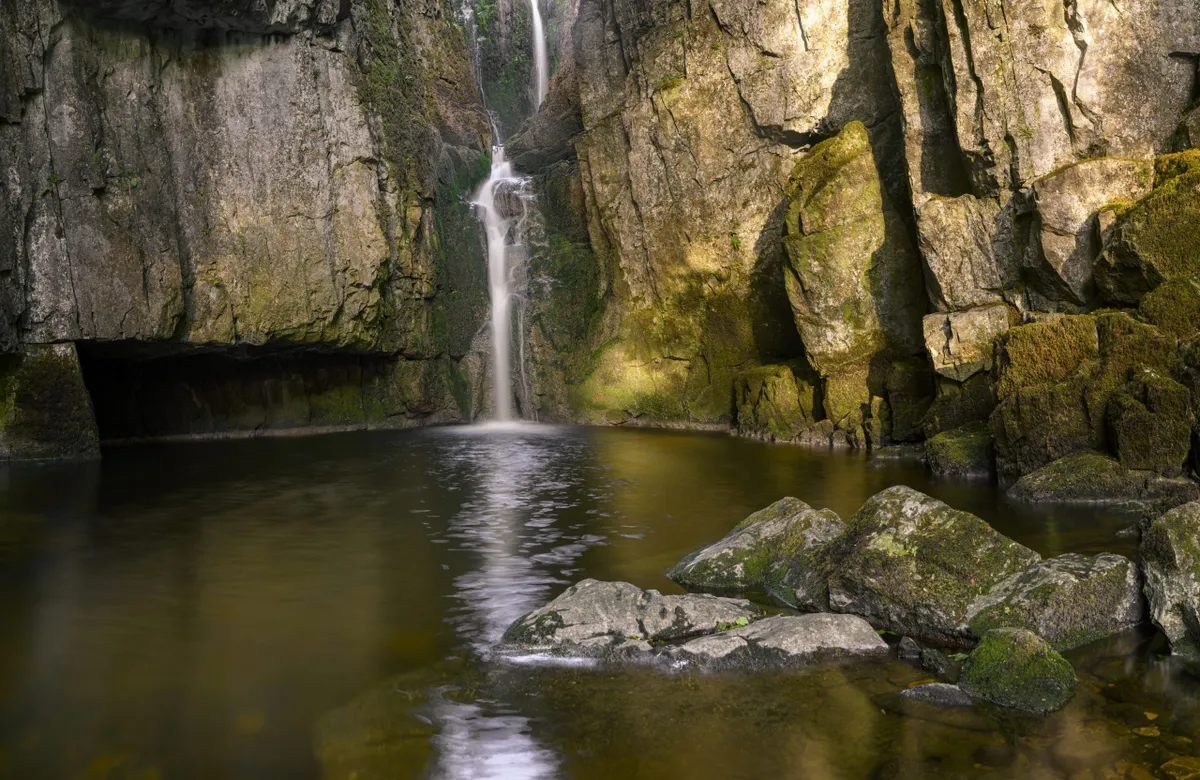
Certainly not up there with the largest or most spectacular waterfalls, Catrigg Force offers something different. The waterfall is in a rather secluded location just north of Stainforth village and is part of the Yorkshire Dales National Park. It is perfect if you just want to relax and enjoy nature at it’s finest.
Jesmond Dene, Tyne and Wear
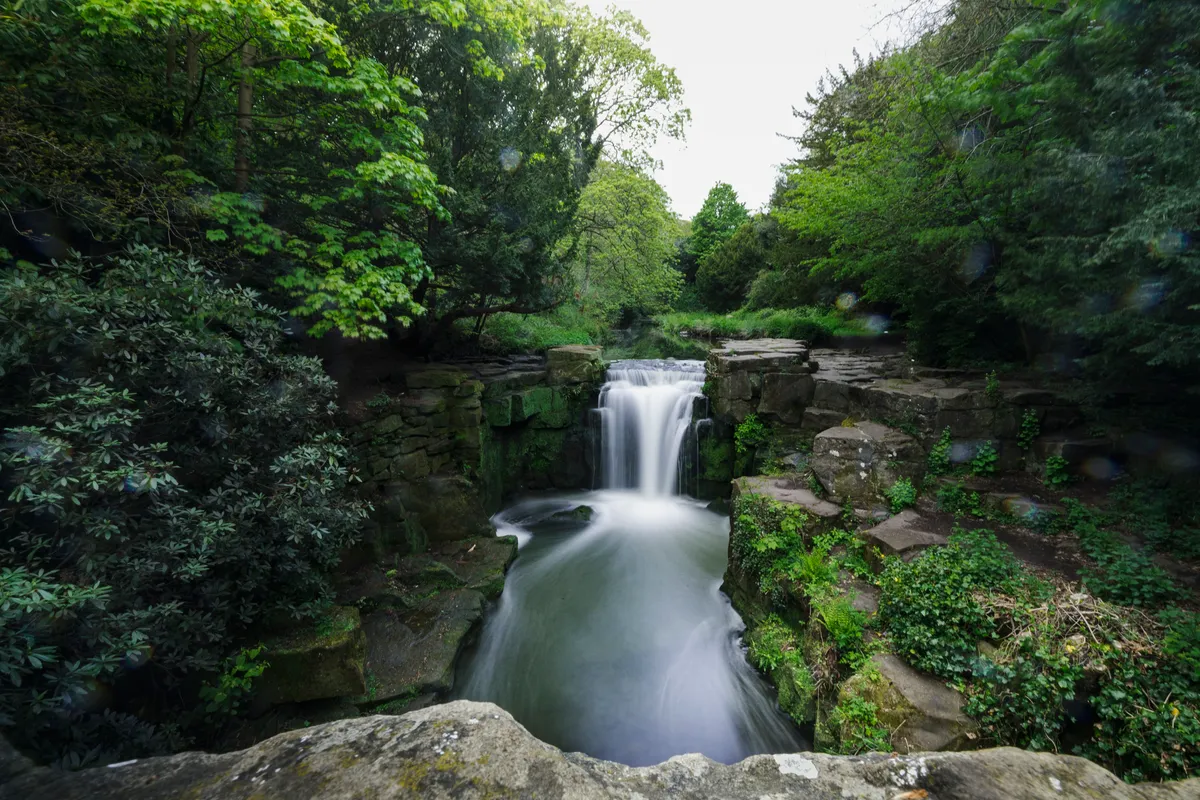
Tumbling down from the north of Newcastle, the Ouseburn river rises most magnificently as it passes through Jesmond Dene on its six-mile journey from Callerton to the city centre.
The Ouseburn is a glacial stream that cut south to the Tyne as the last ice age melted away (‘dene’ is a regional term for a ravine). Here, there is an astonishingly rural, peaceful rhythm for somewhere so close to the city.
Microclimates sprout up here and there; dense, mature rhododendrons and rhubarb-like gunnera transform damp groves into an experience of walking through a gloomy jungle. Meanwhile, mosses and ferns take advantage of every crack and cranny.
Hareshaw Linn, Northumberland
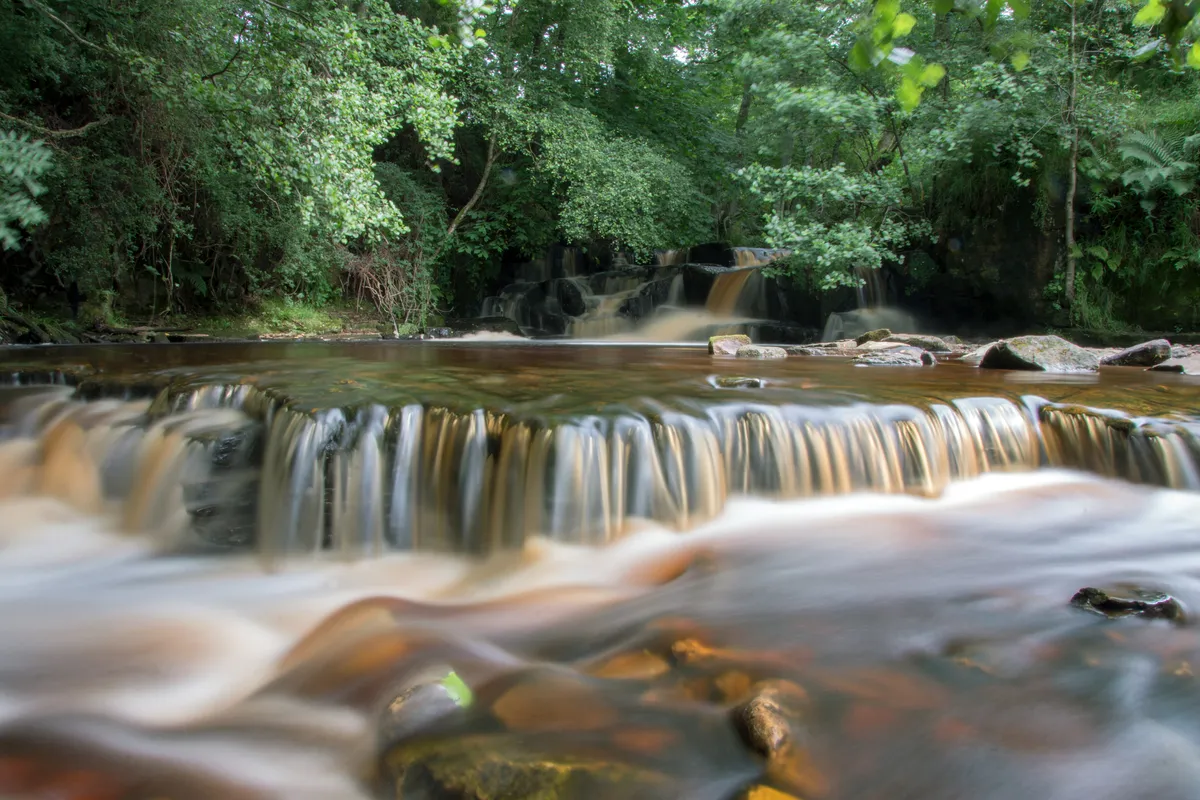
As you head out of Bellingham, you would find it hard to believe that, 150-odd years ago, this was an industrial landscape filled with the sounds of roaring furnaces and rattling mine trucks.
Around you are spoil heaps from coke ovens and a quarry, as well as abandoned mineshafts, but nature has reclaimed the landscape of Hareshaw Linn and transformed it into a magical site, all tinkling water and twittering birds.
The best waterfalls in Scotland
Steall Falls, Scottish Highlands
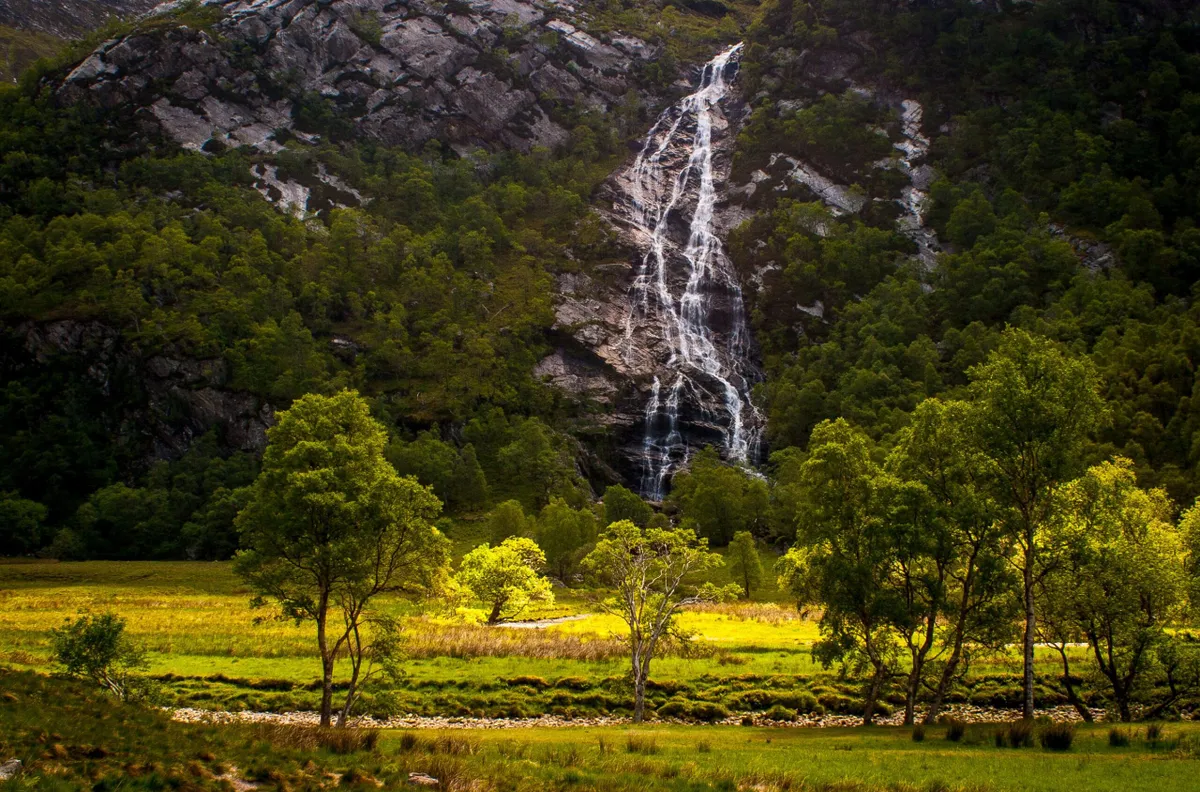
The magnificent An Steall (also known as Steall Falls or The White Spout) is Britain’s second highest waterfall. It plummets 120m from the slopes of An Gearanach into the River Nevis and is spectacular in its scale and force.
A two-mile walk climbs on a rocky, rollercoaster path through Glen Nevis to reach the epic Steall Falls. The combination of tumbling river water, soaring mountain views and hillside woodland makes this a true microcosm of the Scottish Highlands.
Falls of Bruar, Perthshire
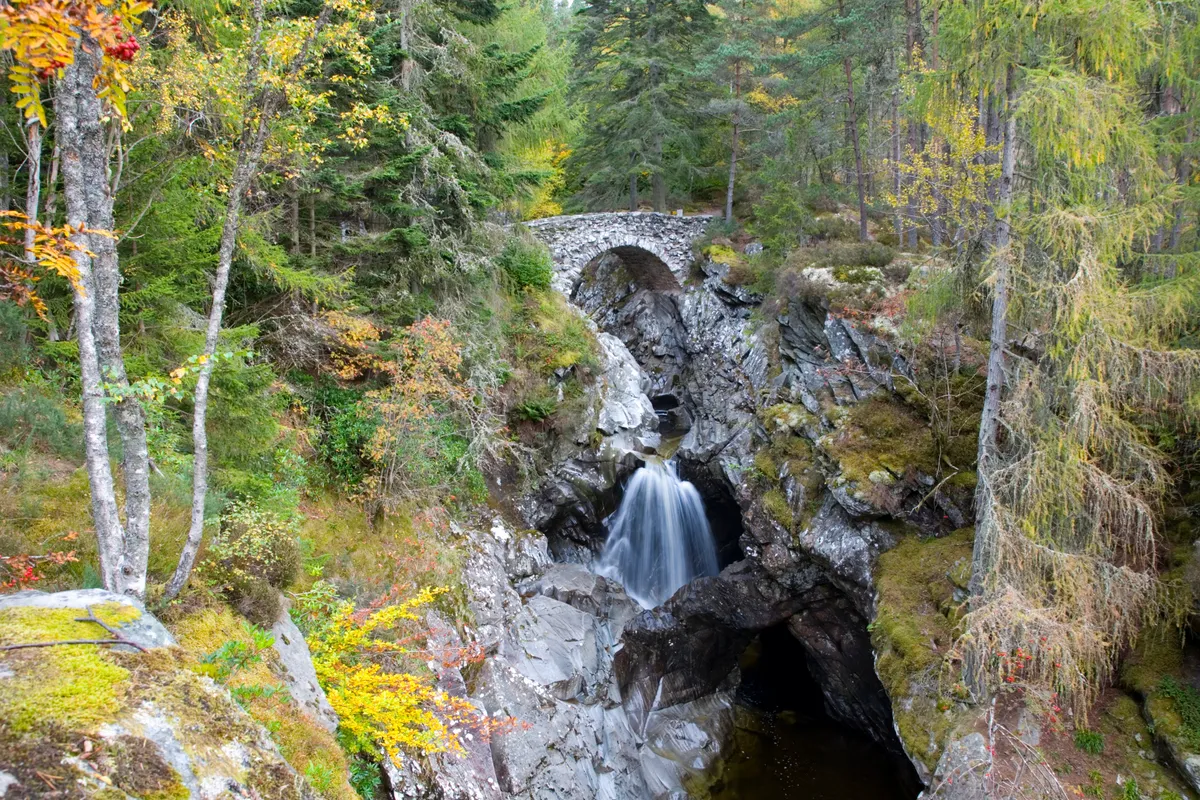
The Bruar Water, just north of Blair Atholl, oozes from the soggy plateaux and moors of the great Atholl Deer Forest and flows gently down the empty miles of Glen Bruar before changing character completely.
As the ground falls away, the waters become increasingly agitated and turbulent, before crashing and thundering down a deep gorge. At the foot of the gorge the water of the Falls of Bruar roars over a series of falls and cascades, before surging through a natural arch in the rock and into the pools below.
Rouken Glen Park, Glasgow
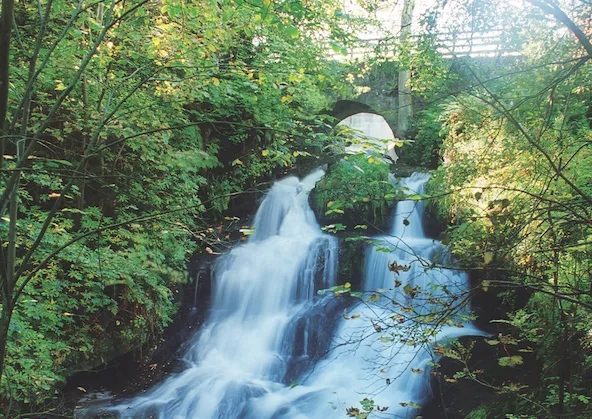
Once known as Birkenshaw, meaning Birch Wood, this historic park just south of Glasgow is a peaceful blend of woodland, water and gardens. The falls, found in the south of the park, were diverted and enlarged more than 200 years ago and used to provide energy for the Victorian textile industry.
Falls of Clyde, New Lanark
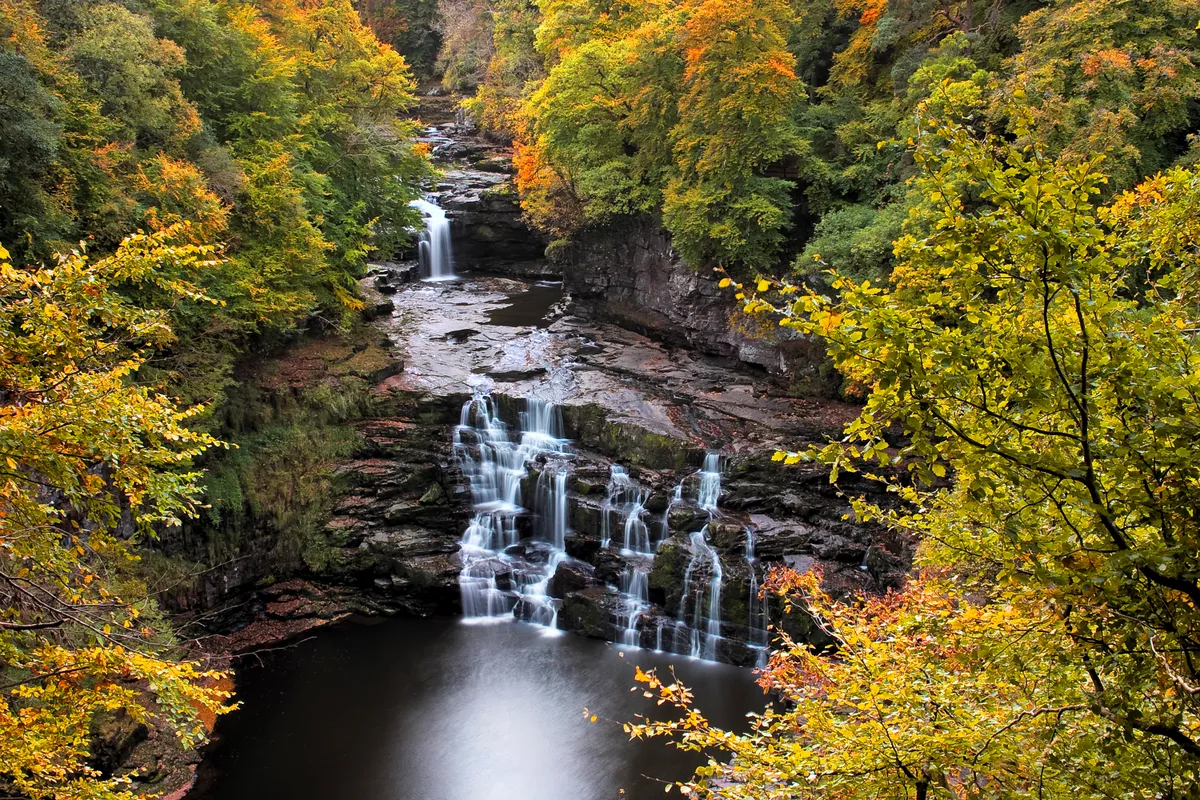
This achingly beautiful wild haven in southern Scotland is famous for its spectacular salmon leap waterfalls and scenic woodland walks along the river. Over 100 bird species have been recorded, including ravens, dippers and kingfishers along with bats, otters and badgers.
Bracklinn Falls, Stirlingshire

Popular since the onset of tourism in Victorian times, Bracklinn Falls sits near the holiday-feel town of Callendar – a gateway to the Highlands under the shapely peak of Ben Ledi.
Leading through mixed woodland, below notched crags, the short walk to the falls is an ideal length for all the family.
In the woods, you stand a good chance of spotting red squirrels, especially if you are quiet. The tufty-eared creatures are a delight to watch and, if you’re lucky, you’ll see them scarpering through trees at lightning speed and on to impossibly thin branches in search of pinecones. These stripped cones often litter the forest floor. You will also hear the thrum of woodpeckers and perhaps spy a roe deer.
Falls of Measach, Highlands
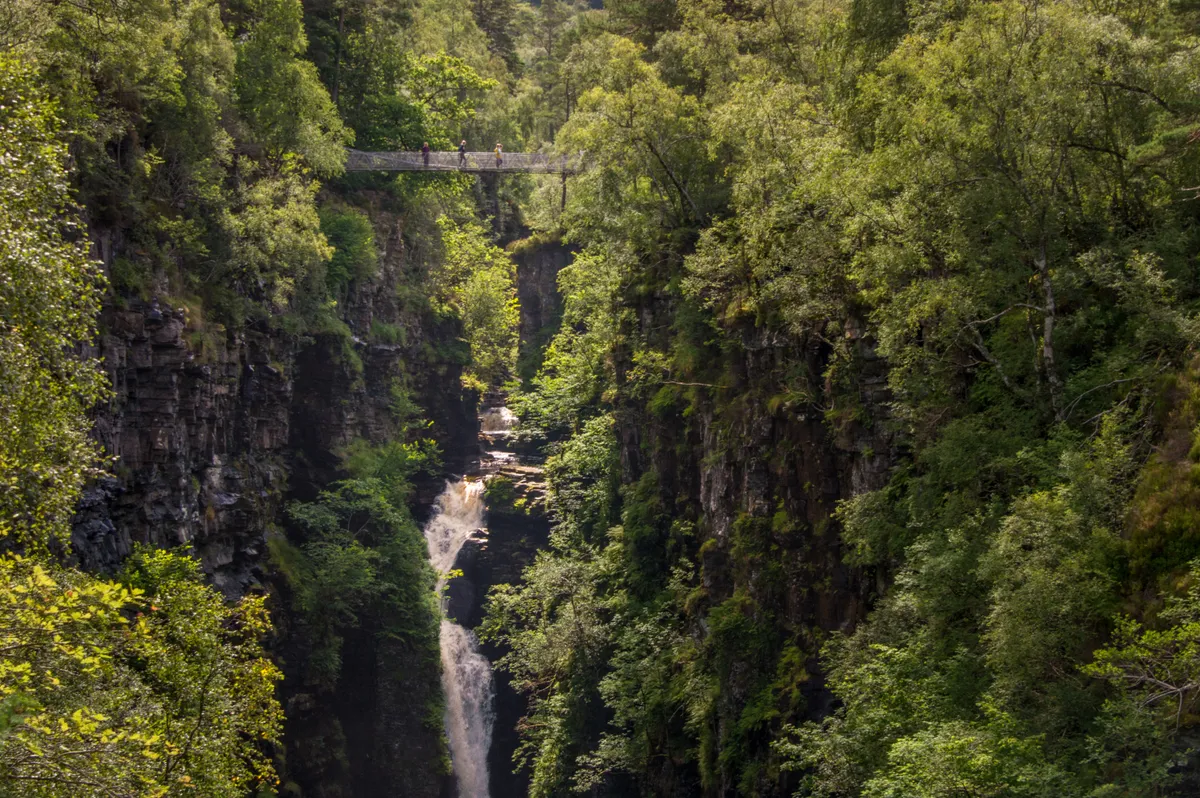
View the thrilling Falls of Measach from a number of spectacular viewpoints on this short walk through Corrieshalloch Gorge National Nature Reserve near Ullapool.
You are guaranteed to be awestruck with your first sight of the vertigo-inducing Corrieshalloch Gorge and the Falls of Measach.
One of the most spectacular of its type in Britain, Corrieshalloch provides striking evidence of how glacial meltwater can create deep gorges. A Victorian-era suspension bridge spans the gap above the 200-foot-deep chasm, where you can gaze at the long, crashing waterfall.
In winter, when the River Droma that flows through the ravine is in spate, the experience is electric.
Grey Mare’s Tail, Dumfries and Galloway
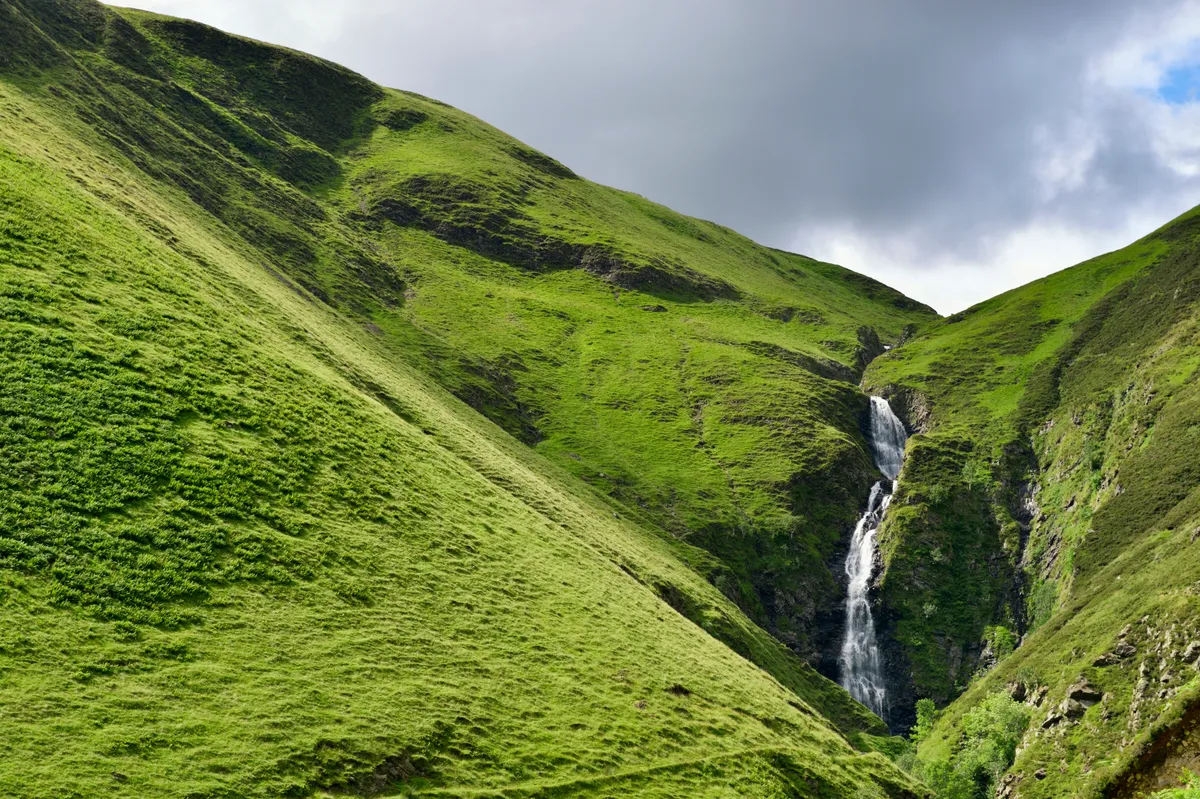
The Grey Mare’s Tail Nature Reserve lies on the eastern edge of Dumfries and Galloway, near the boundary with the Scottish Borders. Nearby Moffat, 10 miles to the west, was the first ‘Walkers are Welcome’ town in Scotland and makes the perfect base for year-round exploration of the peaks and valleys of the Southern Uplands.
The Grey Mare’s Tail falls are iconic, especially for the ice climbers who come to scale them when the cascades freeze (the last time, in 2010, temperatures reached -22°C). To have a go yourself you need Mountain Instructor accreditation, but the hillside path makes a good vantage point for watching the climber’s daring deeds.
Aysgill Force and Hardraw Force, North Yorkshire
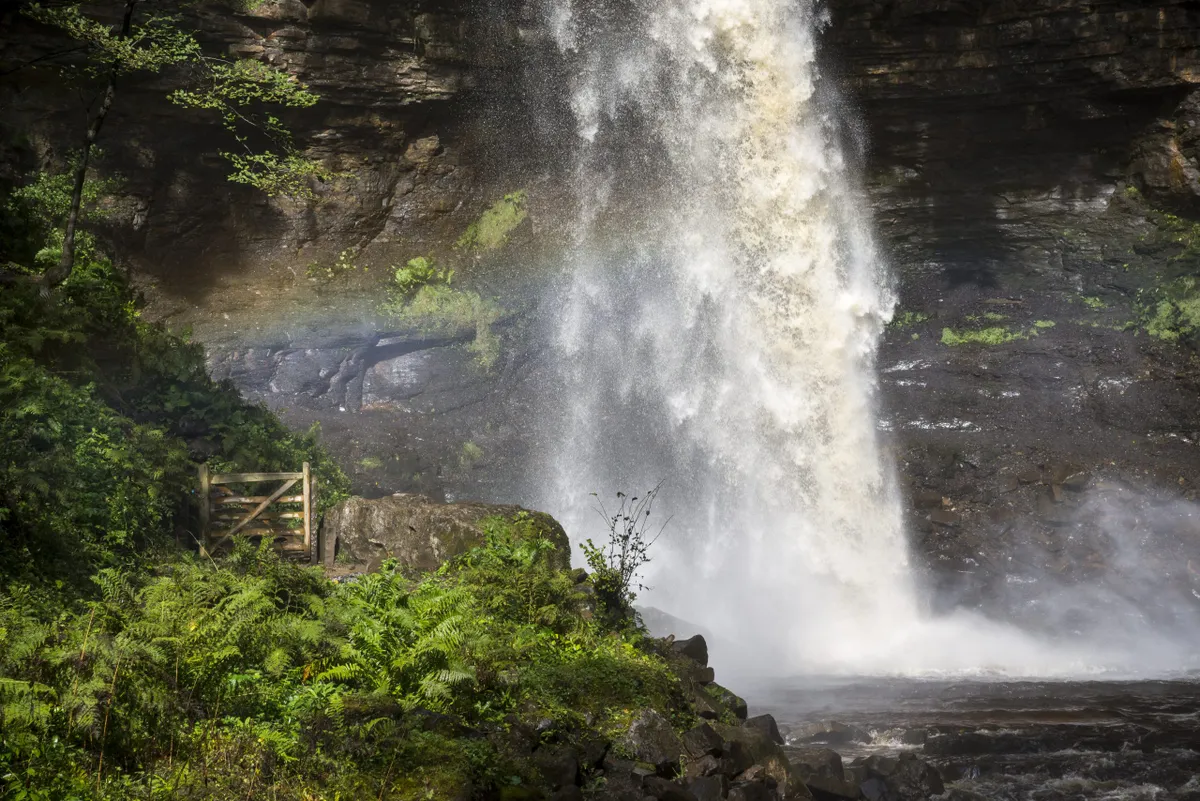
An abundance of falls, chutes and cataracts together make Upper Wensleydale the epitome of Yorkshire’s beguiling waterfall country. And at its heart is delightful Hawes, a miniature town, major market centre and locus for countless rambles to magical falls amid the cocooning hills - including Aysgill Force and Hardraw Force.
The best waterfalls in Wales
Waterfall Country, Powys
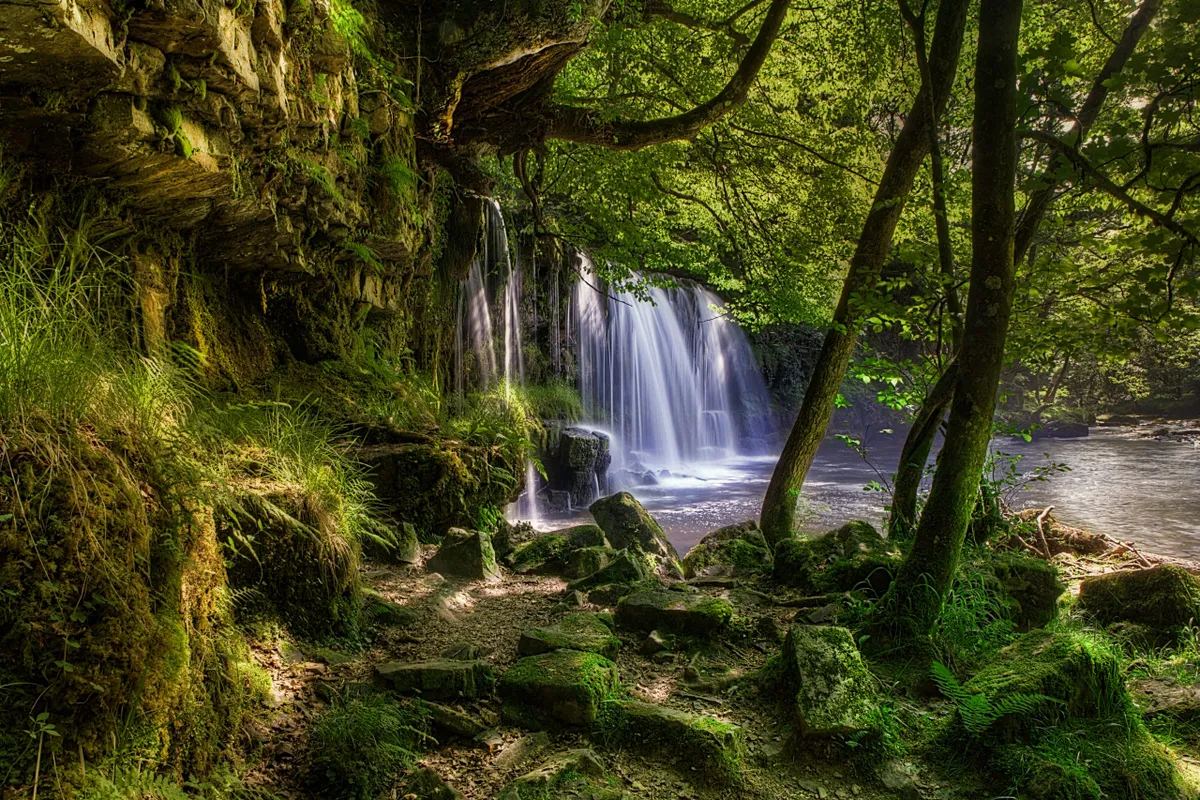
“I cannot call to mind a single valley that… comprises so much beautiful and picturesque scenery and so many interesting and special features.” With these words, Victorian naturalist Alfred Russel Wallace was describing neither the Amazon nor the Far East that he explored on his intrepid travels, but somewhere much closer to home: the Vale of Neath on the southern slopes of the Brecon Beacons.
Spilling water, mossy riverbeds and tree-shrouded caverns – Waterfall Country is a ramblers dream.
Pistyll Rhaeadr, Powys

The Pistyll Rhaeadr falls are born in the Berwyn mountains. The Afon Disgynfa is, at first, not unlike the other streams formed by rain leaking out of the moors.
But the Disgynfa doesn’t survive its sudden plummet over a sheer shelf of volcanic rock, a landform tough enough to have escaped the scouring of the glaciers in the last ice age. Transformed by the falls, the waters continue their journey as the Afon Rhaeadr.
Spray from the cataract nurtures mosses and ferns. Around them, protected from sheep in a walled enclosure, beeches, birches, oaks and pines thrive. From a distance, the wooded gorge and falls resemble an almost Tyrolean scene, which is usually a fecund refuge for squirrels, woodpeckers and finches sheltering from the Berwyns’ icy blasts.
Bodnant Garden, Conwy
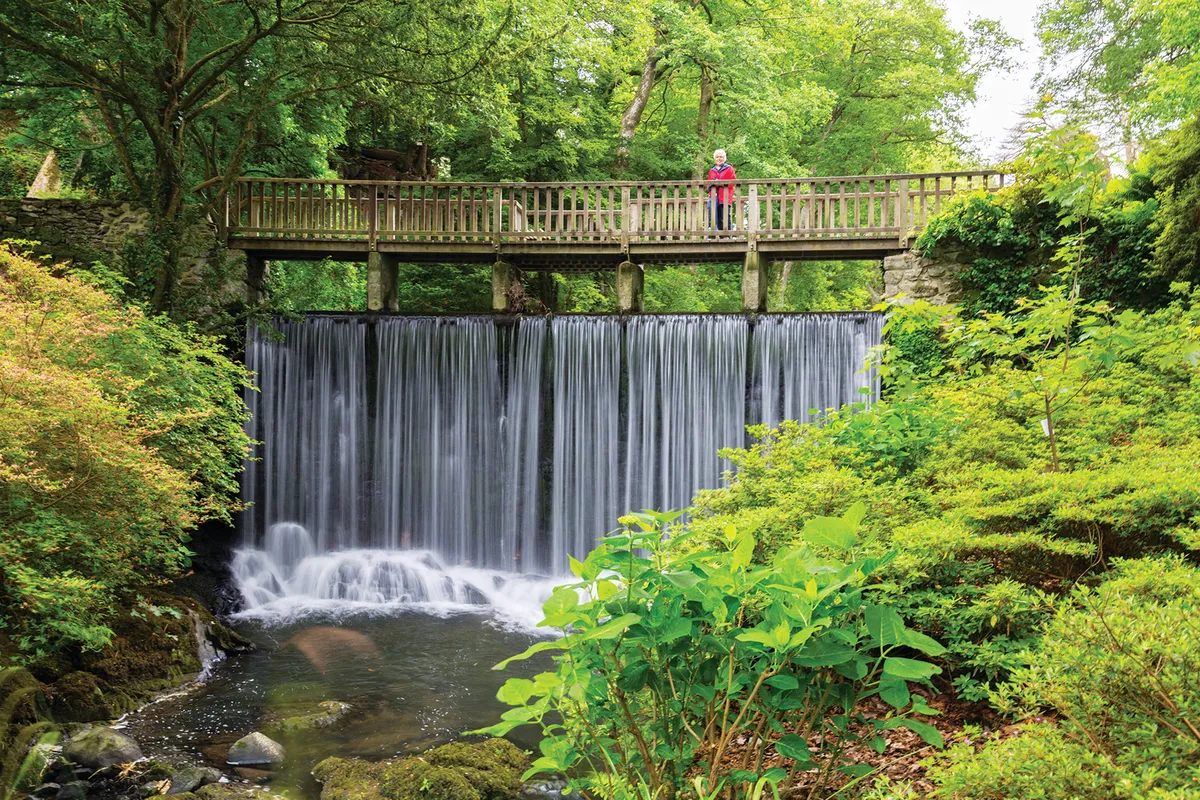
Cleverly designed to allow water beneath it, people across it and eels through it, the Waterfall Bridge forms a dam between Bodnant’s lake and the rhododendron-lined Afon Hiraethlyn. This Snowdonia garden also includes grand lawns, colourful terraces, wildflower meadows and enormous trees.
Aber Falls, Gwynedd
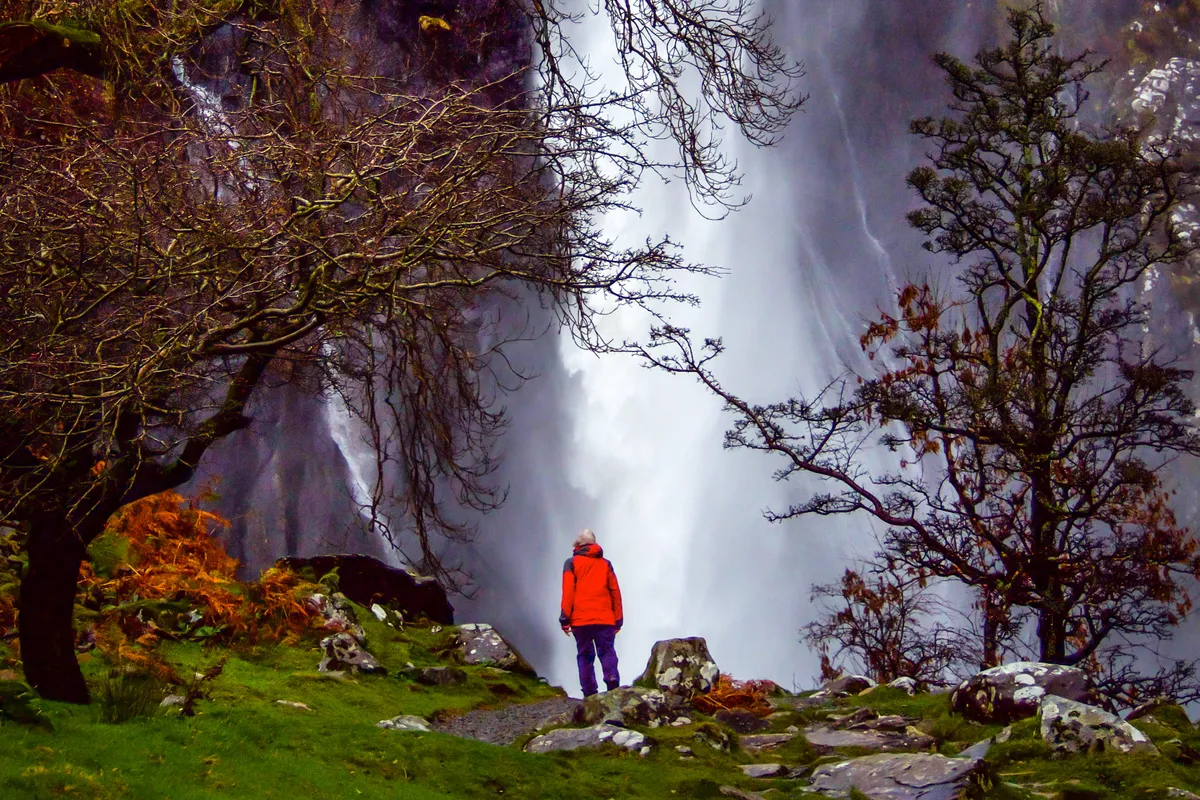
Cascading through oak, birch and hazel woodlands below a scree-strewn hillside is Aber Falls. The river boasts one of the steepest gradients from source to sea in England and Wales and the 120ft-high falls are at their most impressive after heavy rains.
The woodland is a good habitat for birds, which are more easily spotted in the winter months when the trees have no leaves. Look out for dippers bobbing on the boulders in the river, while ravens, buzzards and peregrines soar in the skies above.
Nant Bochlwyd, Conwy

Almost 200m above the magical Llyn Idwal National Nature Reserve are the mercury waters of Llyn Bochlwyd. For many, this small, isolated lake offers a welcome stopping point en route to the vertiginous heights of Tryfan – one of Snowdonia’s most prized summits.
But the pool has another secret – Nant Bochlwyd – an unruly cascade that spills from its outflow between two huge rocky buttresses that conjure visions of Tolkien’s Gates of Argonath, or The Pillars of Kings.
Water-break-its-neck, Powys
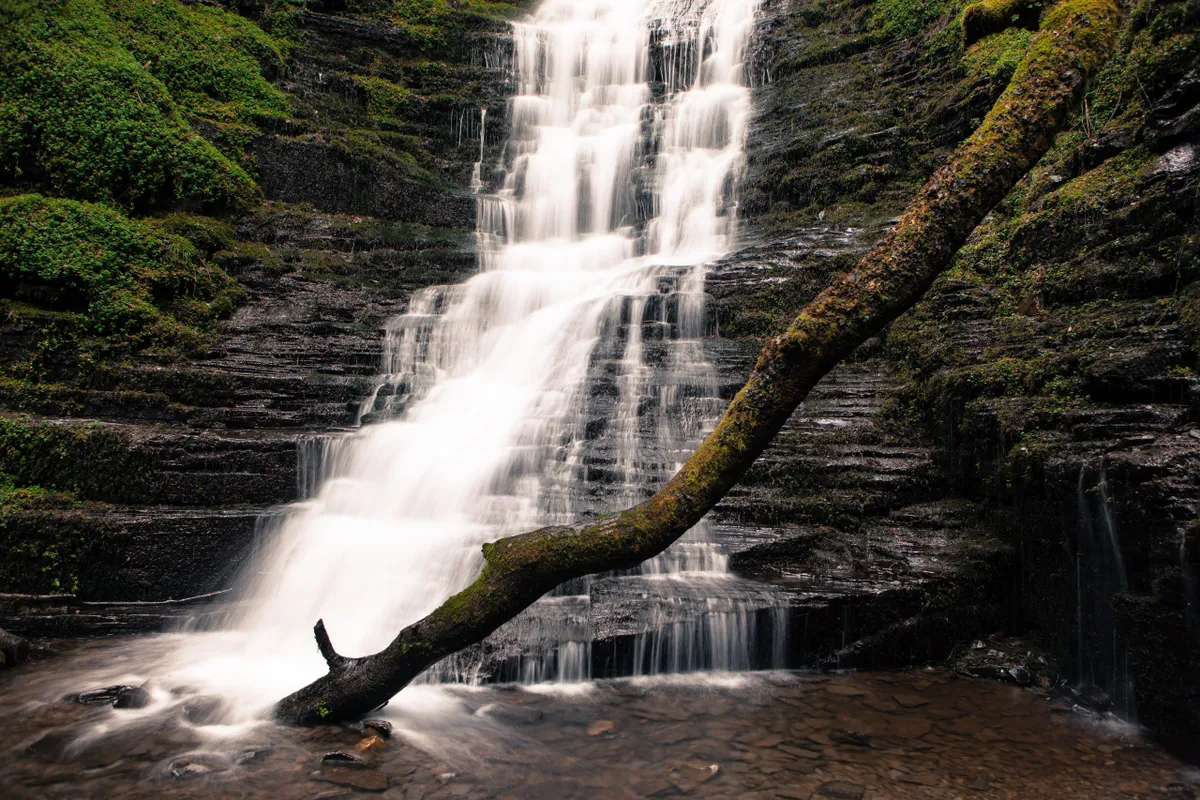
It can sometimes be challenging, with a young family, to find walking trails manageable for little legs. Thankfully there is an ideal place in the Radnor Forest in Mid Wales. There are three short trails in the wood, each waymarked with coloured signs. All three routes are worth walking – here we follow the Water-break-its-neck Trail (blue waymarkers).
Caban Coch Dam, Powys
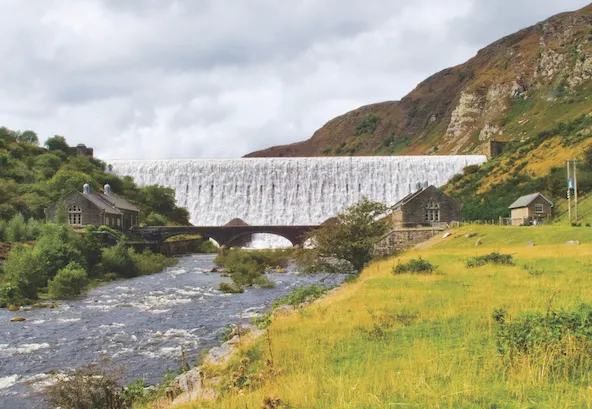
Built as part of the Elan Valley reservoirs project to provide Birmingham with drinking water, Caban Coch is the lowest dam in a sequence of four. In spate, water cascades in great volumes over the wall, dropping more than 35m to the Afon Elan below.
Pistyll Cain, Gwynedd

In Snowdonia’s rain-soaked forests, everything is clean and wet. Mist rises, trees transpire, moisture kisses your skin and wets your lips. Oxygen-rich air lifts your spirits and the sound of water fills your ears as it trickles down tracks, bubbles through moss, and crashes in creeks.
The Mawddach bashes and caresses the rocks in its bouldery creek. Flashing water, too swift for plants to grow in, scours the rock and shingle bare. As you leave the evergreens for broadleaf woodland it sounds louder, ricocheting round its rocky creek, the whisky-coloured water exploding into jacuzzis of white bubbles.
At Pistyll Cain, the noise is cacophonous. You can see the falls well enough from the footbridge, but if you’re sure-footed you can scramble around the slippery rocks to perch where little plants grow in crevices. White water plummets into the canyon down a stepped cliff, crashing with such force into the dark pool that it creates a permanent uprush of wave and spray, its turbulence shifting the air into cool thrilling winds.
More than 30 species of mammals have been recorded within a five mile radius of Coed y Brenin, including water voles.
Pistyll Rhaeadr, Powys
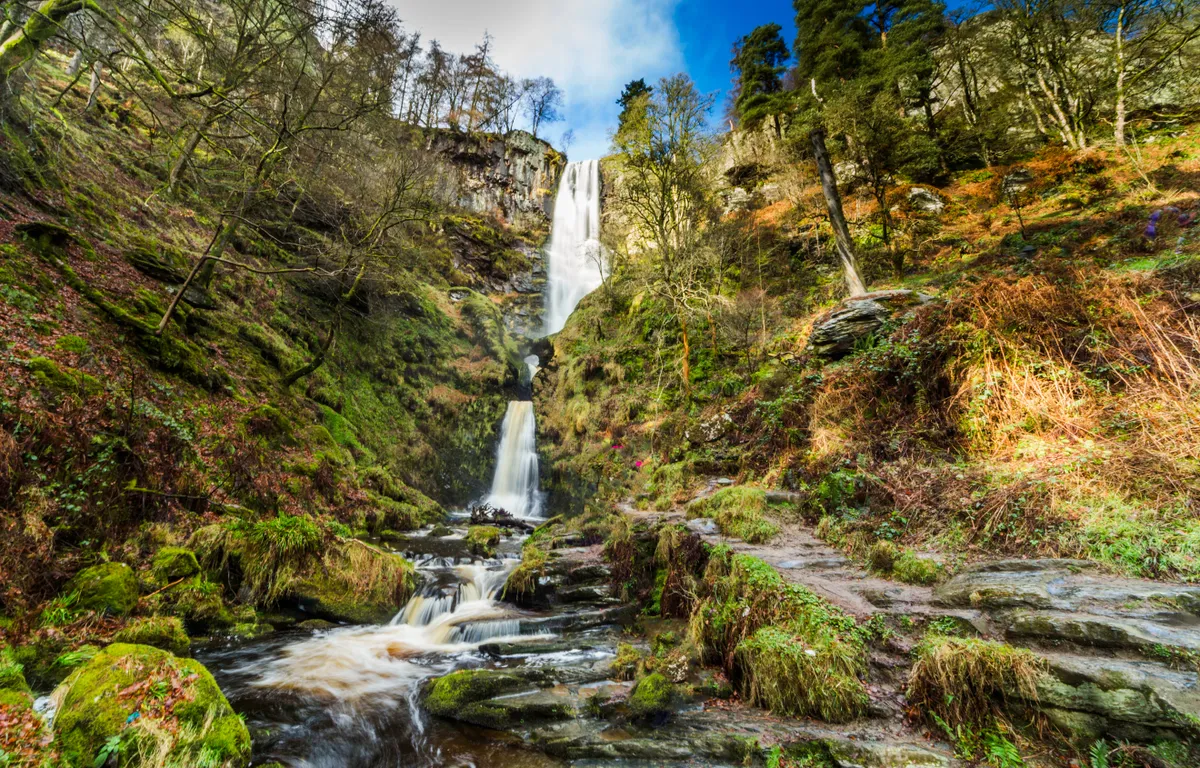
Spray from Pistyll Rhaeadr nurtures mosses and ferns. Around them, protected from sheep in a walled enclosure, beeches, birches, oaks and pines thrive. From a distance, the wooded gorge and falls resemble an almost Tyrolean scene, which is usually a fecund refuge for squirrels, woodpeckers and finches sheltering from the Berwyns’ icy blasts.
The best waterfalls in Northern Ireland
Glenariff Forest Park, County Antrim
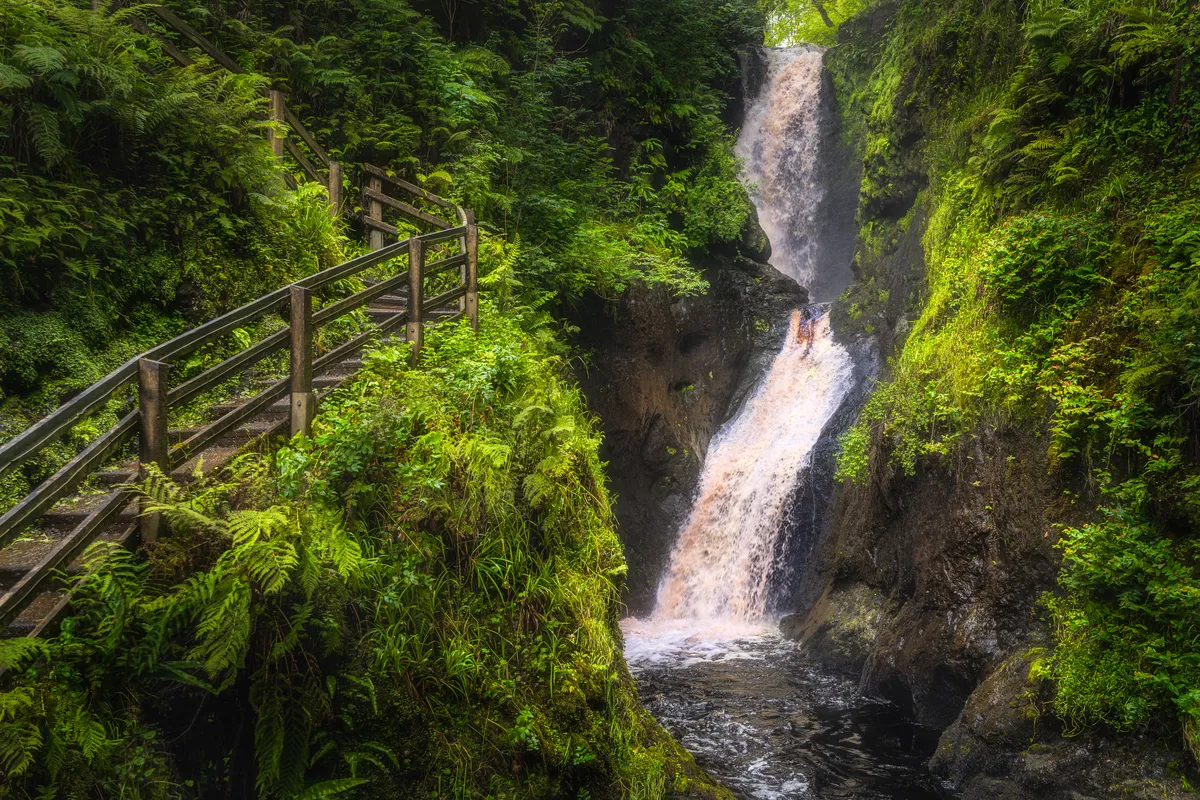
The Rivers Glenariff and Inver have cut right through this spectacular steep-sided gorge – the Queen of the Glens. These Northern Irish rivers can be lively and dramatic as they tumble over boulders and a series of three impressive waterfalls. But then they become suddenly calm and tranquil, flowing lazily through oak and beech woodland, sunlight streaming through the fresh new leaves.
This humid and moist microclimate is home to rare ferns, mosses and liverworts, as well as spruce, fir, pine and larch.
